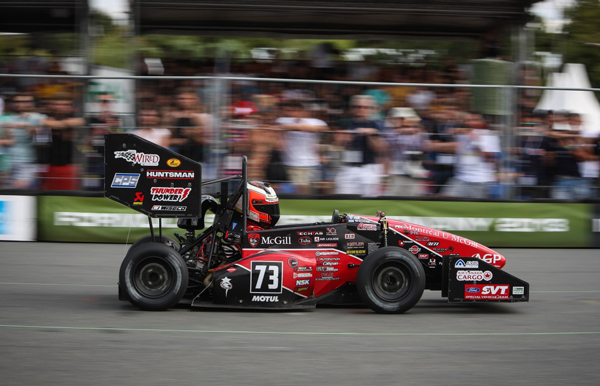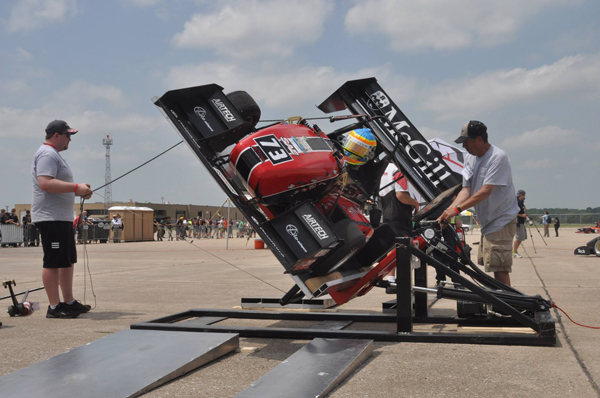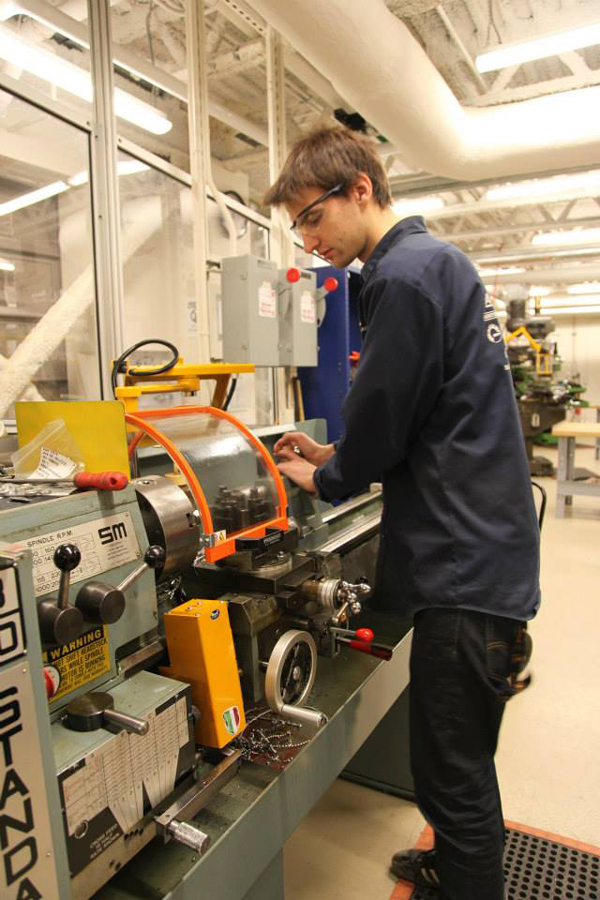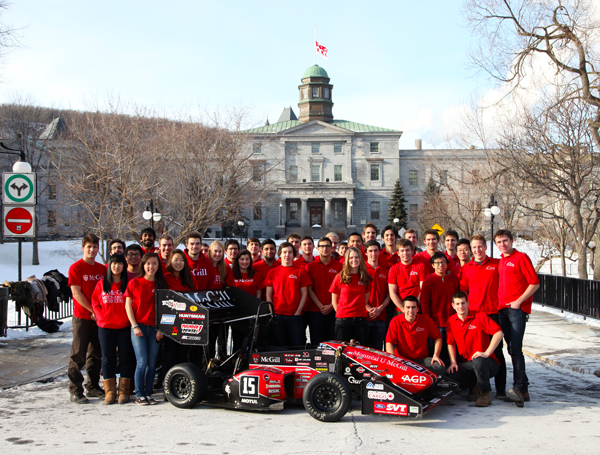
By Christopher Atack
Whether tackling Everest-sized homework assignments, working out complex equations or organizing one of their legendary social events, McGill’s engineering undergraduates are famous for their enthusiasm and “can-do” attitude. But even for highly motivated engineering students, designing and building a top-notch racing car in two semesters on a shoestring budget is a serious challenge. Yet that is exactly what the McGill Racing Team (MRT) has done every year since it was founded in 1994.
Each year, the team designs a Formula-One style car in the fall semester, builds it over the winter and races it in international competitions over the summer months. In 2013, the 60-person team designed, built and raced MRT15, a Formula-One style car based on the design rules set out by the Society of Automotive Engineers (SAE).

Designed to be driven on a very tight track at an average speed of 50 km/h and a top speed of around 120 km/h, MRT15 weighs 400 lbs and boasts a 53 horsepower engine, sophisticated five speed transmission and a whole range of advanced technological features.
The MRT kicked off its 2013 competitive season with an appearance at the Michigan Formula SAE, the biggest SAE event in the world. From there, the team moved to events in Barrie, and Lincoln, Nebraska. Then, it was over Germany, the home of the Formula Student Germany, the most prestigious show in the world, and on to Helsinki for the Baltic Open. A final event, the Toronto FSAE Shootout at Mosport Race Track, wound up the season. When the dust had settled, the MRT15 topped the competition across Canada, as well as chalking up very respectable scores in international events.
Advanced methods and tools
The team’s 2014 model (MRT16) promises to be even better. “We took a huge leap forward this year, with the design of our new vehicle,” says captain of the Combustion Powertrain Subgroup Lewis Koberg, a third-year Mechanical Engineering student. “We replaced our steel space-frame with a full carbon fibre monocoque chassis and went to great lengths to reduce weight while maintaining stiffness and strength. We’re employing materials and manufacturing methods usually reserved for military/aerospace and Formula 1 teams to build our chassis, and using tools and methods that are advanced even by industry standards.”

Building a state-of-the art Formula SAE race car requires specialized materials and access to expert services. When feasible, parts are made by team members themselves in the Engineering Machine Shop in the McConnell Engineering Building. Some parts, however, are too complex to be manufactured in the available facilities. For help with high cost items, the racing team turns to its sponsors, many of whom are major players in the automotive industry. This year, sponsors are contributing over $250,000 worth of materials and services. Their help is key to the team’s success. The MRT16’s chassis alone is worth over $80,000. To design and build the prototype, the MRT used software valued at about $200,000.
Specialized subgroups contribute different skills
Specialization is another key to the team’s success. Because Formula SAE cars are so complex, MRT members are organized into subgroups. “Each subgroup contributes a different set of skills to the team,” says third year engineering student Matthieu Labaudinière, who serves on the MRT Finance, Sponsorship and McGill Politics Management Team. “We have subgroups specializing in suspension, combustion and electrical powertrain, brakes, steering and ergonomics.” Engineering undergraduates as well as students from other faculties also manage the team’s administration, finances and communications – and of course, drive the car.
To ensure the best possible performance, drivers practice using go-karts, and by driving the team’s car from April until the snow flies. Training in go-karts makes sense, because driving one is very much like driving a Formula SAE car, according to Koberg, who is one of the team’s drivers as well as a member of the powertrain subgroup.
“A Formula SAE car has the same low-to-the-ground, nimble, compact ‘feel’ as a go-kart, but it’s much more powerful and can corner much harder,” he says. “If a Formula One racing car and a go-kart were to have a child, it would be a Formula SAE car – although its technology would resemble the Formula One ‘parent’ more than the go-kart.”
Since the MRT team competes during the summer, members often forgo summer jobs – and much-needed income – in order to represent McGill. However, their long hours of unpaid work can pay huge long-term dividends in experience and contacts. Members of the MRT team gain hands-on experience in the automotive sector, valuable exposure to the world-wide engineering community and the opportunity to build lasting relationships with professional engineers and sponsors.
Some MRT members commit their time because they are passionate about cars or racing,” Koberg explains. “Some are interested in the manufacturing aspect and some love the detailed design work that goes into every vehicle component. Still others enjoy the challenge and want to be a part of an exciting team. It comes down to curiosity, desire to learn and motivation to excel. Time and time again, we hear from industry professionals that the experience MRT members gain from Formula SAE puts them way ahead of their peers – and ultimately helps them become better engineers.”
Click on individual photos to enlarge them.
To learn more about the McGill Racing Team, go here or check out the Facebook page.

